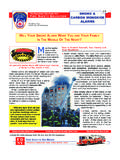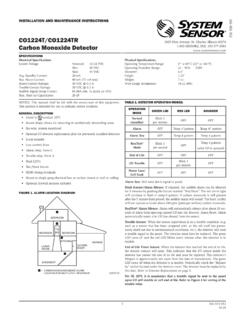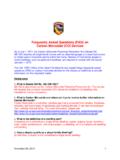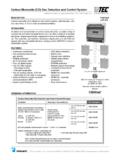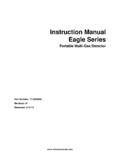Transcription of Long-term reliability and use scoping study
1 Health and Safety Executive Domestic carbon monoxide alarms Long-term reliability and use scoping study Prepared by the Health and Safety Laboratory for the Health and Safety Executive 2011 RR847 Research Report Health and Safety Executive Domestic carbon monoxide alarms Long-term reliability and use scoping study Peter Walsh Harpur Hill Buxton Derbyshire SK17 9JN carbon monoxide (CO) is an invisible, odourless and tasteless gas produced in the home by any fuel-burning appliance. Properly installed appliances are designed to combust fuel efficiently and produce little waste CO; any CO that is produced is either vented from the room to outside by a flue or chimney, made inert by a catalytic converter associated with the appliance, or is left to disperse naturally. CO alarms are widely recommended as one of a number of important measures to protect against the health risks associated with CO leaks from fuel burning appliances. The expected lifetime of CO alarms has been increasing since their introduction in the mid-1990s and some current models have an expected lifetime of more than 6 years under normal operation.
2 This report seeks to derive evidence on the reliability and use of CO alarms currently employed in UK domestic settings, to support consumer advice regarding their effectiveness and usage. This report and the work it describes were funded by the Health and Safety Executive (HSE). Its contents, including any opinions and/or conclusions expressed, are those of the author alone and do not necessarily reflect HSE policy. HSE Books Crown copyright 2011 First published 2011 You may reuse this information (not including logos) free of charge in any format or medium, under the terms of the Open Government Licence. To view the licence visit , write to the Information Policy Team, The National Archives, Kew, London TW9 4DU, or email Some images and illustrations may not be owned by the Crown so cannot be reproduced without permission of the copyright owner. Enquiries should be sent to ACKNOWLEDGEMENTS We acknowledge the assistance of carbon monoxide Awareness Ltd (Charity), Council of Gas Detection and Environmental Monitoring (CoGDEM) and Gas Safe Register in specifying the project; Gas Safe Register in collecting the CO alarms and administering the questionnaires; CoGDEM in providing new, replacement alarms; and the householders for agreeing to test their alarms.
3 Ii KEY MESSAGES carbon monoxide (CO) is an invisible, odourless and tasteless gas produced by any fuel-burning appliance. Properly installed appliances are designed to combust fuel efficiently and produce little waste CO. Audible CO alarms can be used to detect when CO reaches levels which may be hazardous. For this report, approximately 100 CO alarms, previously used by people in their homes, were tested and their use analysed. The key messages of this report are: Sensors in CO alarms don t last forever check the manufacturer s quoted lifetime for your CO alarm and replace it no later than recommended to ensure you continue to have adequate protection.
4 Before purchasing a CO alarm, always ensure it complies with British Standard EN 50291 and carries a British or European approval mark, such as a Kitemark. Standards for the performance of CO alarms have become more stringent over recent years and so older alarms may not react as quickly as newer alarms. Check the manufacturer s recommendations about how you can test your alarm to ensure that the unit and the batteries are in good condition. Ensure that your CO alarm is correctly located check the instructions from the manufacturer. Over 20% of alarms sampled were not fitted correctly, mainly due to being at the wrong height or not close enough to the potential source of CO. Audible carbon monoxide (CO) alarms are a useful back-up precaution, but they are not a substitute for the proper installation and maintenance of combustion heating appliances. carbon monoxide can be generated by any combustion fuel and so it is important that all appliances are installed and maintained by competent engineers.
5 For gas appliances by law this should be a Gas Safe registered engineer, for solid fuel appliances the approved body is HETAS, and for oil appliances the approved body is OFTEC. iii iv EXECUTIVE SUMMARY carbon monoxide (CO) is an invisible, odourless and tasteless gas produced in the home by any fuel-burning appliance. Properly installed appliances are designed to combust fuel efficiently and produce little waste CO; any CO that is produced is either vented from the room to outside by a flue or chimney, made inert by a catalytic converter associated with the appliance, or is left to disperse naturally.
6 CO alarms are widely recommended as one of a number of important measures to protect against the health risks associated with CO leaks from fuel appliances. The expected lifetime of CO alarms has been increasing since their introduction in the mid-1990s and some current models have an expected lifetime of more than 6 years under normal operation, leading to some manufacturers offering warranty periods of 5, 6 or even 7 years. However, concerns have been expressed as to the reliability of these alarms over an extended period. This report seeks to derive evidence on the reliability and use of CO alarms currently employed in UK domestic settings, to support consumer advice regarding their effectiveness and usage. The objectives of the study reported here are: 1. To estimate the reliability of domestic CO alarms, which have been in normal service in consumers homes, based on the 330 ppm CO test, for those certified to the British standard BS EN 50291, or the 400 ppm CO test, for those certified to the US standard UL 2034.
7 2. To derive information on the domestic use of CO alarms, from data obtained from householders by questionnaire, and relate such data to the recommendations contained in the guidance standard BS EN 50292. 3. To recommend good practice with regards to the effective use of domestic CO alarms in the UK. A total of 110 households with a CO alarm installed in their home were recruited to the study . Each home was visited during which the alarm identified for testing was uninstalled, replaced with a new alarm, and a study questionnaire was administered. The questionnaire was administered by a Gas Safe Register Inspector and was designed to record specifics regarding the alarm and its use, including the alarm make and model, its age, where it was sited in the home, whether it was correctly sited, and how often it was tested. Other, more general information on the property was also collected, such as property type, tenure, and specifics regarding the fuel appliances present in the property.
8 Alarm reliability was assessed under laboratory conditions by testing conformity to one of two standards relating to performance of CO detectors deployed in domestic premises, either the British (European) standard, BS EN 50291 for UK certified models, or the US standard, UL 2034 for US certified models. The test methodology was agreed between HSE, HSL, carbon monoxide Awareness Ltd (Charity), Council of Gas Detection and Environmental Monitoring (CoGDEM) and Gas Safe Register, and involved initial push button testing, followed by sensor inclusive gas testing. With regards gas testing, alarms certified to BS EN 50291 were tested using the highest CO concentration (330 ppm) test specified in the standard; the standard requires activation of the alarm within 3 minutes following the initiation of exposure. Alarms certified to UL v 2034 were tested using the equivalent high concentration (400 ppm) test specified in the standard; this standard requires activation of the alarm between 4 and 15 minutes following the initiation of exposure.
9 Effectively, two aspects of CO alarm use were investigated as part of this study : the reliability of alarm sensors to detect CO according to specific requirements set out in BS EN 50291 or UL 2034, and whether the alarms were appropriately used and deployed in homes by householders, according to BS EN 50292 guidelines. With regards to laboratory testing, alarms tested as part of the study were classed as fails for one of two reasons (or potentially both): (a) because they failed the initial button testing (9% of all alarms tested), either because batteries were simply absent or depleted (6%), or a more permanent sealed-battery or electronic failure (3%); or/and (b) because they failed subsequent gas testing (1% of alarms tested). It is worth noting that two thirds (6/9) of the alarms failing initial button testing, failed simply because the batteries powering the alarms were depleted.
10 The percentage of households in the study reporting previous CO problems in their home was 6%; the profile of these households was mixed, including those in both owner occupied and rented properties, those with both open and balanced flue fuel appliances, and those in terraced, semi-detached and detached properties. Consumers in this study who tested their CO alarms did so by using the push button, thereby essentially testing the electronics of the alarm. Products are, however, currently available for consumer use, which utilise CO gas to test the sensor of a CO alarm. Variability in alarm age and failure rates in the alarms gas tested were both insufficiently high to allow reliability of alarms of greater than 2 years in age, along with factors potentially affecting alarm failure, to be investigated in detail. Based on the analyses that could be undertaken, the following inferences may be made: The reliability of the most common models of CO alarms available in the UK, particularly over their first four years of life, as judged by conformance to the British standard BS EN 50291 and the broadly equivalent US standard UL 2034, appear to have improved significantly since the last study of this kind in 2003.










